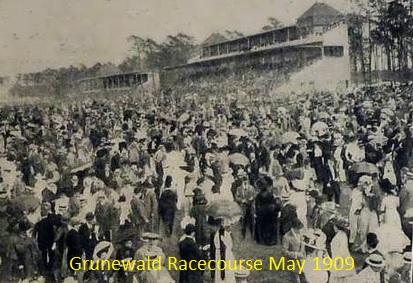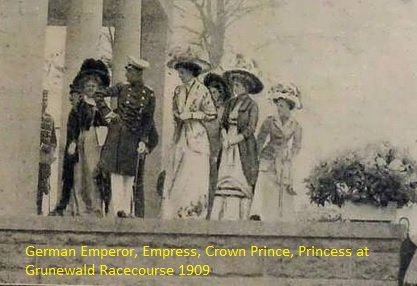In the early years of the 20th century a racecourse existed in the present day Westend region of Berlin, on the northern edge of the Grunewald forest. The stadium was designed to be multi-purpose, not only as a horse racecourse, but more importantly to host the 1916 Summer Olympic Games. Prior to becoming a racecourse the land was a sandy region on the Teltow plateau close to the Spree river. A wealthy group of Berliners, the Berliner Rennverein, first had designs on building a racecourse in 1907 when the land was leased to horse racing enthusiasts known as the Union-Klub. They commissioned Otto March to design the racecourse which held its inaugural meeting, in the presence of Emperor Wilhelm II, on Sunday 23rd May 1909. Whilst he and his entourage arrived in cars, at the same time a railway station was opened enabling the course to be accessed by a much larger group of people. A crowd of 50,000 attended the first meeting, with Tote receipts totalling 400,000 marks. Once it was agreed that the 1916 Olympic Games should be held at the stadium, plans were devised setting out what the stadium should look like. However, there were financial difficulties associated with its building, and it was only in a 200 day period in 1913 that the plans came to fruition. Like the racecourse, it was designed by Otto March, and it was opened on 8th June 1913, the very day Emperor Wilhelm II celebrated his silver jubilee. In the end the First World War put paid to the 1916 Olympic Games being held at the station.
Today it is commonplace for a jockey to ride at more than one meeting each day, often being transported by helicopter. But it was certainly not the norm in 1913. However, on Saturday 14th June 1913 Lieutenant Von Egan Kruger, a military airman and one of Germany's best jockeys, won a steeplechase at Magdeburg Racecourse on Jaspia, before travelling 80 miles in 90 minutes on an army balloon, enabling him to ride Dragoon in the 5th race, the Potsdam Gold Cup worth £125 at Grunewald Racecourse, a race which he won to record a unique double.

In 1914 Fred Winter, successful jockey and National Hunt trainer, saw the Kaiser at Grunewald Racecourse shortly before the War broke out. Fred was interned for a couple of months before being transferred from prison to Ruhleben Racecourse, a trotting track near Berlin. He remained there for 4 years, sleeping in a bunk bed inside a horsebox which housed 6 bunks altogether.

The area was used during the War as a military hospital and after the War international football matches were staged at the stadium. Horse racing continued after the War ended, although the stadium was finally demolished in 1934.



